Foeniculum vulgare
Fennel, Foeniculum vulgare, is an aromatic Mediterranean herb in the Apiaceae (Umbellifer) family that includes carrots, celery, dill, and parsley.
The edible yellow blossoms, seeds, feathery leaves, pollen, roots, and stems have long been prized for their robust, anise-like fragrance and flavor, and their usefulness as ingredients in cooking, magical potions, and traditional medicine.
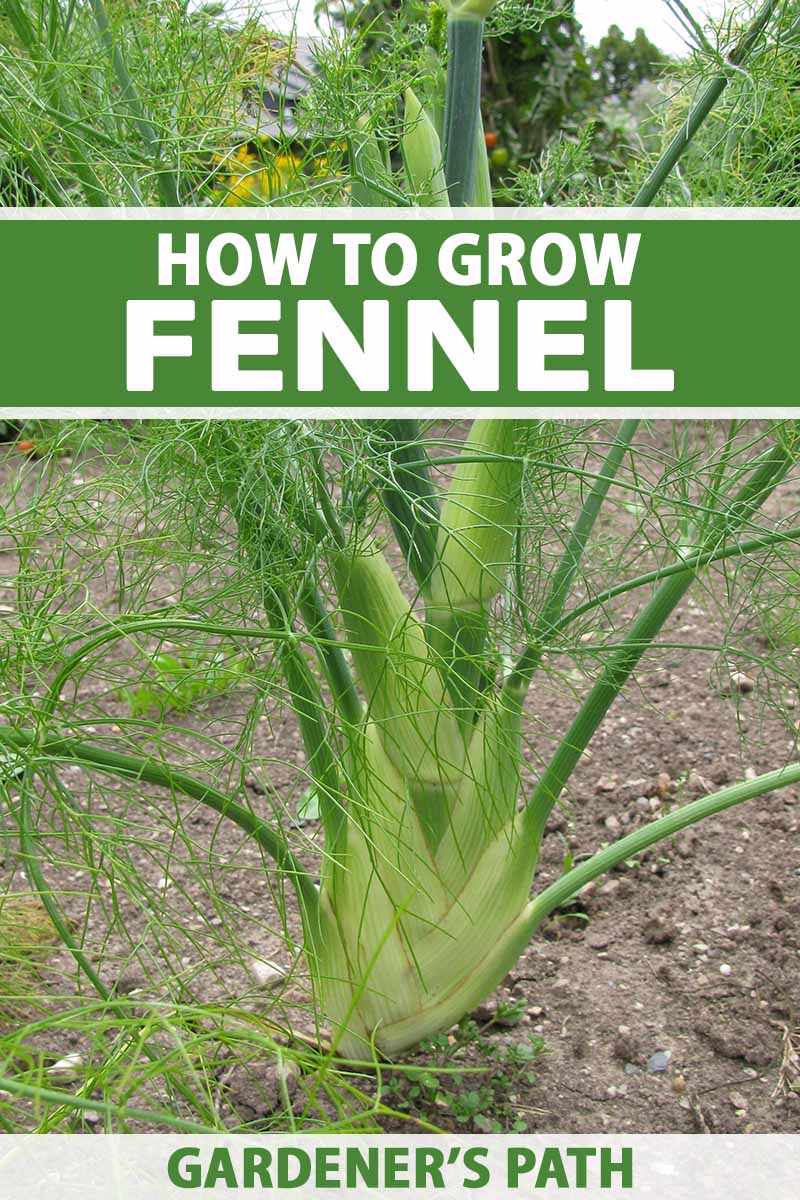
We link to vendors to help you find relevant products. If you buy from one of our links, we may earn a commission.
The vulgare species is the sole member of the Foeniculum genus.
Within it, there are numerous subspecies and cultivated varieties, such as common fennel, F. vulgare ssp. vulgare, and bulb-forming Florence fennel, F. vulgare var. azoricum.
F. vulgare is a prolific self-sower, so much so that the common variety has naturalized to the point of being invasive throughout California and the West.
If you grow the common type, you can prevent its spread by removing flower heads before they run to seed.
The Florence variety is usually harvested before the flowers grow, so it is less likely to self-sow.
In this article, I will cover how to cultivate and harvest both common and Florence fennel in your garden.
What You’ll Learn
Remember to consult with your local agricultural extension service before adding fennel to your herb garden.
And please note:
It is possible to be allergic to F. vulgare. Per the Mayo Clinic’s patient healthcare on food allergies resource, if you are allergic to birch or mugwort pollen, and suffer from “oral allergy syndrome,” you may react adversely to fennel consumption.
In addition, if you have known food allergies, particularly to peaches, you may be unable to consume any part of this herb safely.
And finally, some people may experience skin irritation from physical contact with this plant.
Cultivation and History
F. vulgare has upright, branching growth, finely feathered green leaves, and yellow blossoms in flattened “umbels,” resembling those of other Apiaceae family members.
There are two subspecies of F. vulgare:
- F. vulgare ssp. piperitum
- F. vulgare ssp. capillaceum
These are wild plants that grow readily along hardscrabble coasts and roadsides.
The distinguishing characteristics are that the first has short leaves and very bitter fruit (seeds), and the second has longer foliage and a somewhat less bitter flavor.
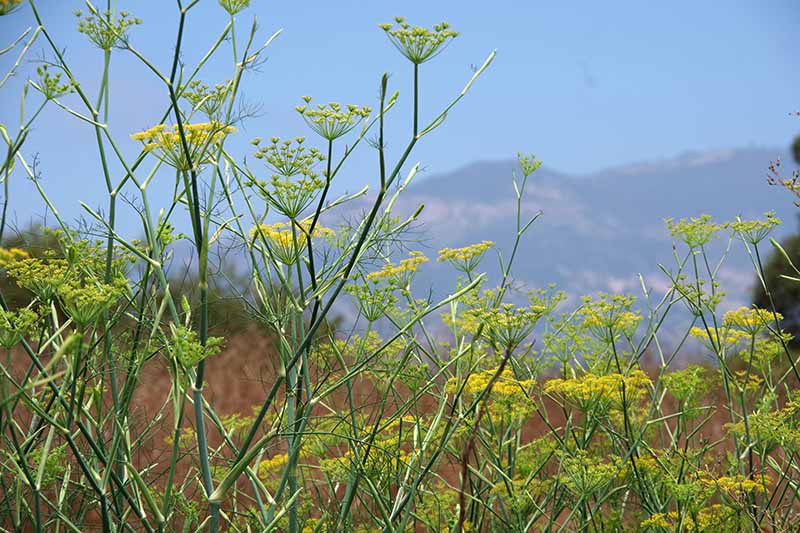
Within the less bitter capillaceum subspecies are three varieties:
- F. vulgare var. vulgare
- F. vulgare var. dulce
- F. vulgare var. azoricum
The vulgare variety, as mentioned, is common fennel, aka sweet or wild fennel. Some have green leaves, while bronze types have foliage with a smoky purple cast.
The bronze-leafed ones are better suited to garden cultivation than their more aggressive wild ancestors.
The dulce type has even sweeter seeds that offer the best flavor when pressed to extract their aromatic essential oils.
And finally, there’s F. vulgare var. azoricum, aka Florence fennel, grown for its crisp, celery-like bulbs bursting with anise-like flavor.
In my family, this vegetable has always been a holiday treat known by its Italian name, “finocchio.”
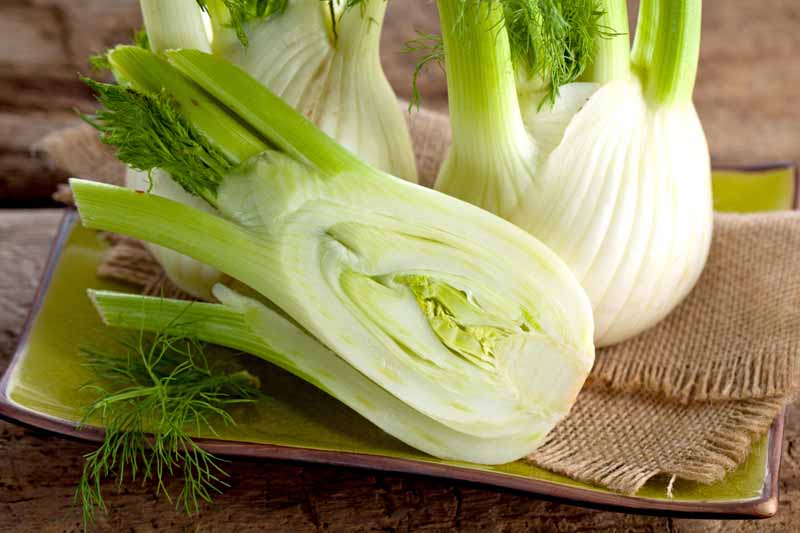
F. vulgare varieties are cool-weather crops that perform best when planted in either early spring, or late summer to fall. It takes 60 to 90 days for them to mature.
The common type is a self-sowing biennial or short-lived perennial in USDA Hardiness Zones 5 to 9. Sometimes it can be successfully cultivated in Zones 4 and 10, as well.
It generally reaches a mature height of three to five feet, but may grow as tall as six feet, like its wild predecessors.
Flowers bloom in mid to late summer.
The Florence (bulb) variety is also a biennial or short-lived perennial that is commonly grown as an annual in Zones 5 to 9.
It grows to a shorter height of two to three feet.
If the bulbs are harvested young, at about four inches across, the plants usually don’t flower, and no seeds form. With a late harvest, or no harvest, flowers may bloom in late summer and self-sowing may occur.
With origins in the Mediterranean region of Europe, fennel has been a culinary, medicinal, and magical arts staple for millennia across Europe, as well as Egypt, China, and India.
It found a welcome place in the kitchen, where the stems, leaves, and fruits were used in recipes to mask poor quality food with the pleasant aroma exuded by its aromatic compounds.
Throughout the Middle Ages, traditional practitioners believed it was capable of curing ailments ranging from anti-inflammatory to GI and pulmonary problems.
In superstitious circles, the mere presence of the herb was thought to ward off evil spirits and render witches’ spells ineffective.
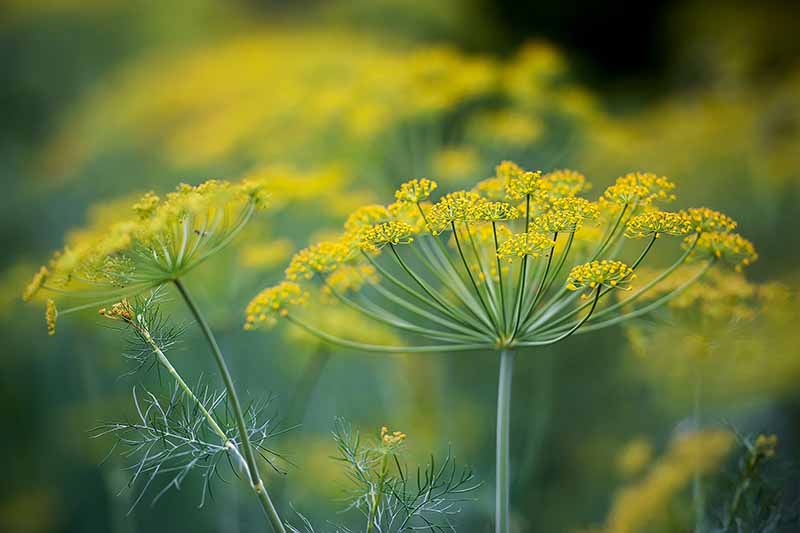
By the 1700s, the familiar herb was classified as F. vulgare Mill, after English botanist and gardener Phillip Miller.
However, by the 1800s, French critic, novelist, and journalist Jean-Baptiste Alphonse Karr decried the herb in his A Tour Round My Garden, in which he stated in his section on fennel, “At the end of three or four hundred years it was discovered that this had never cured anybody.”
Be that as it may, his fellow countrymen of the 19th century had no qualms about consuming it in their favorite green elixir, absinthe.
In modern times, India has taken the lead worldwide in commercial fennel production, and seeds are readily available for home garden planting.
Let’s learn to grow our own!
Propagation
The best way to grow F. vulgare varieties is from seed.
It is possible, but challenging, to start with a root cutting, or division of the crown, the part where the stems meet the roots.
However, these plants have long, fragile taproots and don’t handle disturbance well. So, while you may be able to take a cutting or make a division, it may not transplant successfully.
Unlike some fruiting plants, the seed of fennel and its fruit are one and the same, so the words are used interchangeably.
Fennel seeds can be harvested from plants after the flowers fade, or purchased from quality purveyors.
How to Grow
If you want to grow fennel in the spring, it’s best to start seeds indoors four to six weeks before the last frost date for your region.
Remember, this is a cool-weather crop. If it gets too hot or dry, it may bolt, or run to seed.
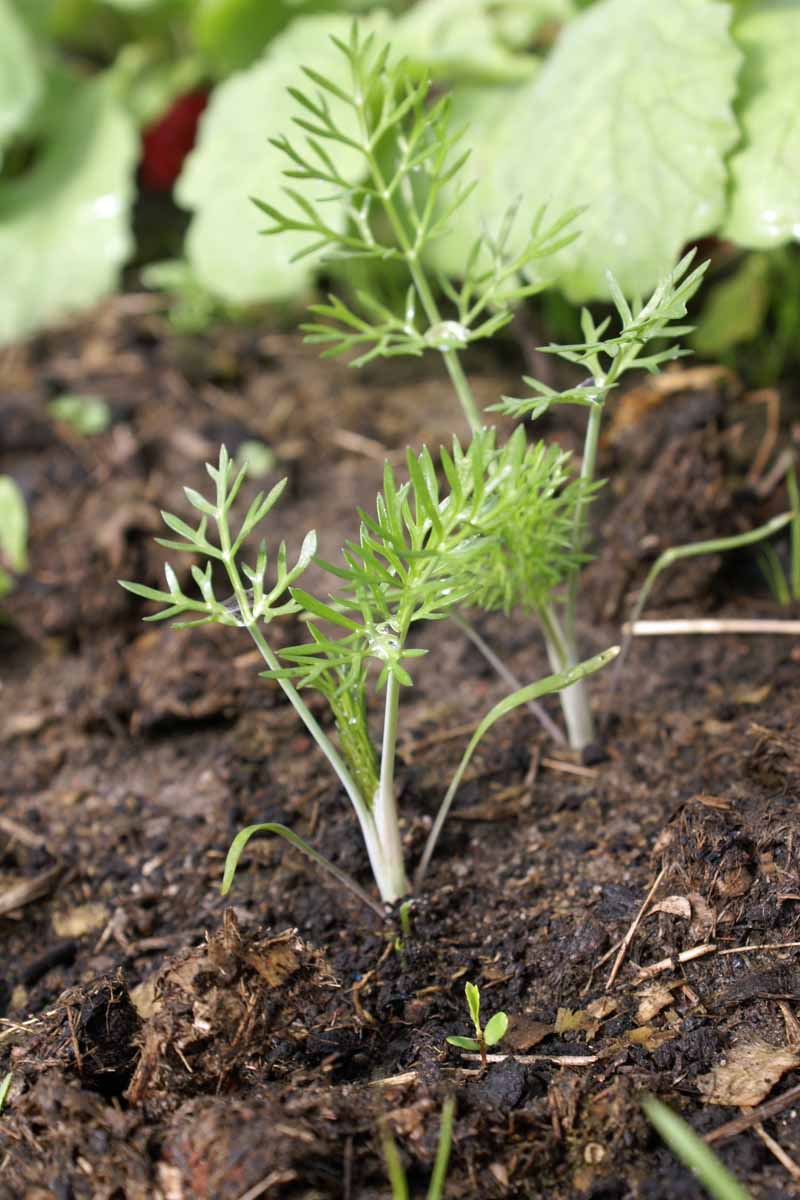
Also, because of the temperamental taproot, it’s wise to use seed starter cells that biodegrade, and transplant them in their entirety to the garden after the danger of frost has passed.
Alternatively, you can direct sow seeds into the garden in late summer or early fall, after the worst of the summer heat is over.
It is a commonly held belief that fennel doesn’t get along well with other herbaceous plants, especially those in the Apiaceae family. Don’t sow it in close proximity, to avoid cross-pollination and adverse effects on flavor.
Choose a location that receives full sun. The soil should be organically rich, well-draining, loose loam. According to the Herb Society of America, the ideal soil pH is somewhere in the range of 4.8 to 8.2.
If you don’t know the composition or pH of the earth in your garden, conduct a soil test through your local agricultural extension service, and amend as needed with compost or other rich organic matter, sand for better drainage, and lime to sweeten overly acidic soil.
Work the soil until it’s crumbly, to a depth of about 12 inches. Add amendments as needed.
Sow seeds a quarter of an inch deep and cover them over with soil.
Place the seeds about four to six inches apart, and allow a walkable 12 to 18 inches between rows, if you are mass planting.
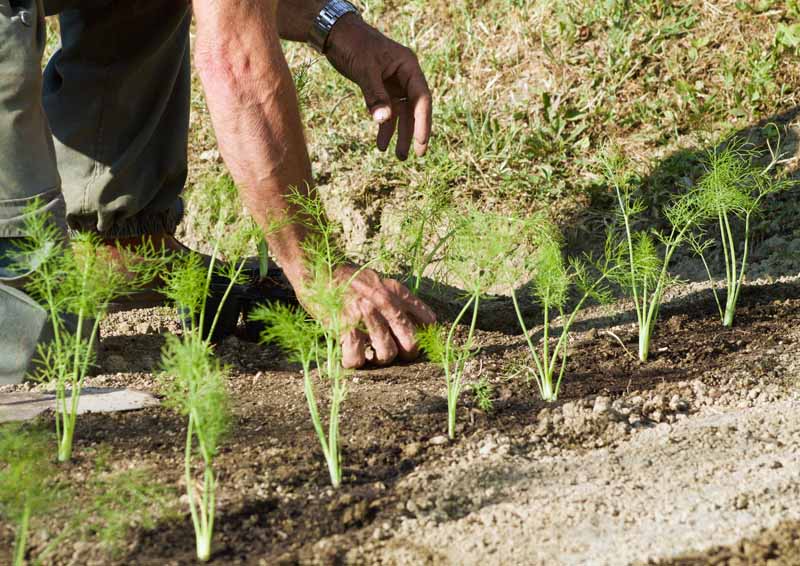
Keep the soil moist during the germination and seedling phases.
However, avoid soggy soil, as it makes seedlings prone to a fatal fungal condition called “damping off,” which causes them to fall over and die.
When seedlings have two sets of true leaves, you can thin them to a distance of 12 to 18 inches apart.
Transfer seeds started indoors to the garden at this time. Let them acclimate to the outdoors by remaining in their seed starter pots for a day or two to harden off before transplanting into the garden.
Continue to water young plants regularly but avoid oversaturation and pooling of water to prevent rotting.
An inch or two of rain per week, or equivalent watering, is usually adequate, although there may be occasions that warrant more.
Bulb varieties are less able to handle dry spells than common types. They are also susceptible to “tip burn,” a condition in which insufficient watering may inhibit calcium uptake and cause the edges of the layers to turn brown.
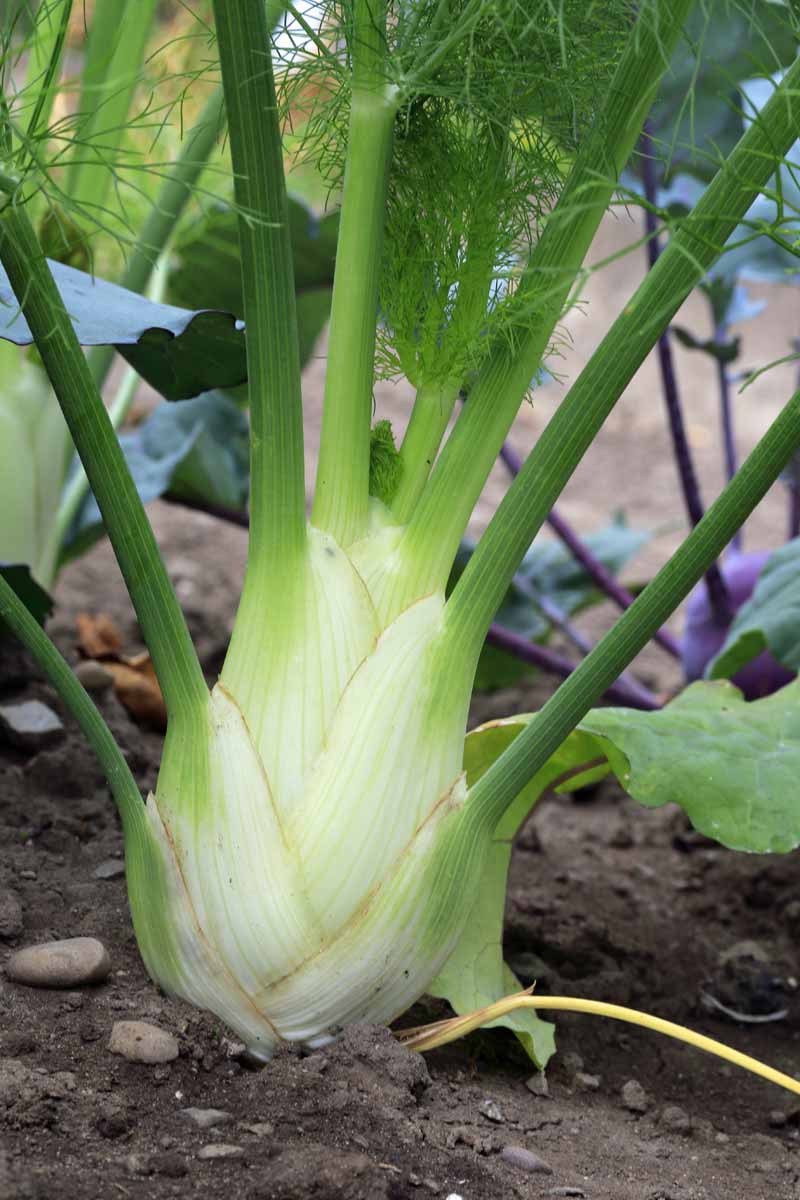
Avert trouble with proper watering and harvest when the bulbs are young and about tennis ball sized, as opposed to older and larger.
You may fertilize Florence plants when the bulbs start to form.
Ken Adams and Dan Drost of the Utah University Extension recommend using three tablespoons of a 21-0-0 (NPK) fertilizer for every 10 feet of rows planted. Nitrogen is essential for the foliar development of F. vulgare varieties.
Do not apply fertilizer before plants are well established. Seedlings that receive too much nitrogen may be at increased risk for damping off.
Common F. vulgare blooms near the end of its growing season. If you don’t want it to drop seeds, you can cut the flowers off and remove them before they begin to fade.
In addition to its value as an edible, it provides an attractive, texturally-rich backdrop in the garden, particularly when it’s a bronze variety.
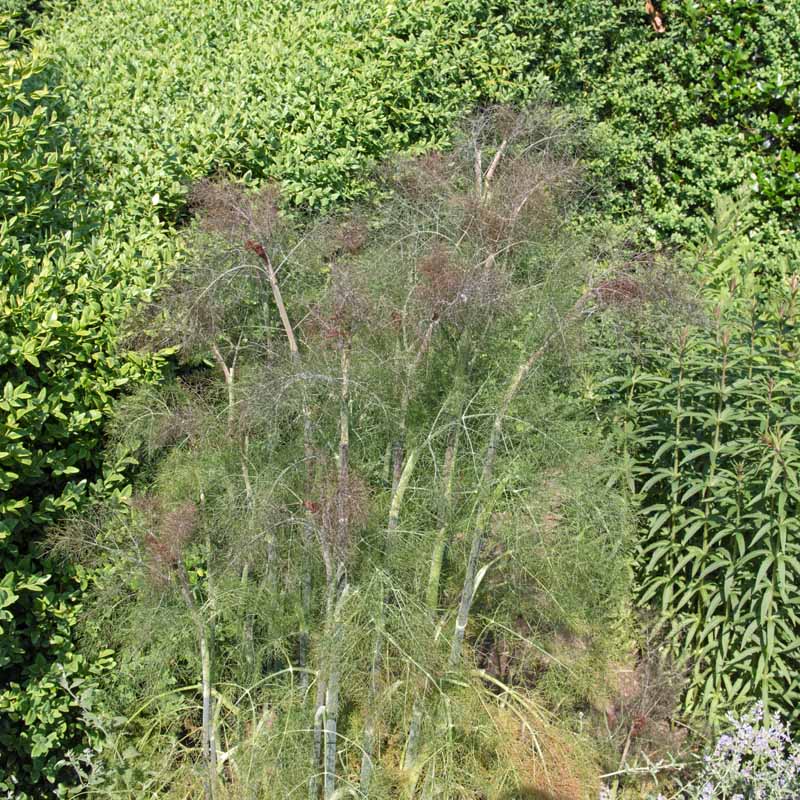
If you are growing Florence types you can keep the bulbs snowy white by mounding soil or mulch up around them when the vegetables first begin to swell.
This technique is called “blanching,” and provides protection from browning in the sun.
Adding mulch over the top of the bulb-like roots of the Florence varieties ensure that they remain white and more satisfying in culinary endeavors.
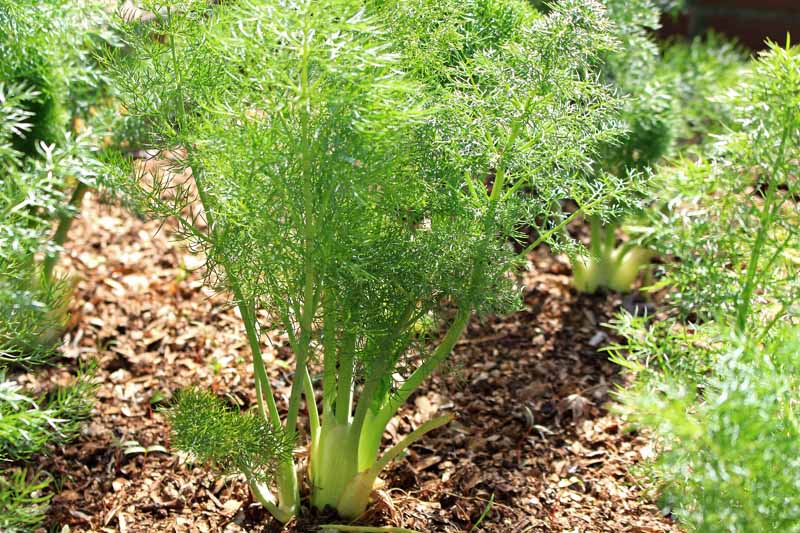
When bulbs are harvested young, at no more than four inches across, there may be no flower bud development at all.
If there is, you can snip the ends off the foliage to prevent bud formation, seed drop, and potentially invasive growth.
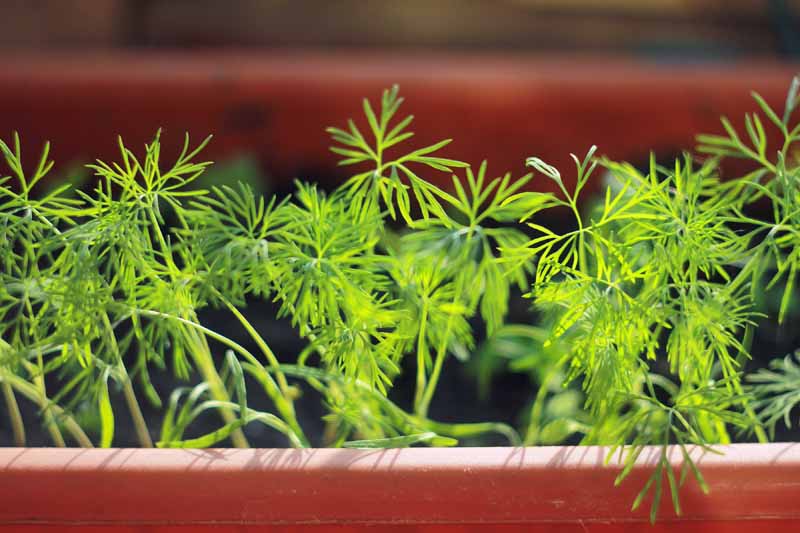
You can also try growing fennel in containers on a patio or balcony. Two things to remember are:
- You’ll need a pot at least two feet deep to accommodate the long taproot.
- Pots dry out quickly, so be vigilant with watering.
In both containers and the garden, plants may require support. A few bamboo garden stakes and some twine can provide the needed stability.
If you’re growing common F. vulgare, you can prune it down by one-third in early summer for a more compact shape.
Note that in areas where summer heats up quickly, you may be better off planting in mid to late summer for a fall crop.
If you should have a particularly warm spell, plants may “bolt” or suddenly go to seed, causing maturity to come to a grinding halt. Foliage and blossoms may be usable, but immature bulbs will probably be a loss.
And finally, weed the garden regularly to reduce competition for water, deter pests, and inhibit moisture buildup that can lead to disease, especially of a fungal nature.
Growing Tips
Whether you grow common or Florence F. vulgare, remember these tips for success:
- Sow seeds in organically rich, well-draining soil.
- Maintain consistent moisture during the germination and seedling stages, and then one to two inches of water per week.
- Limit self-sowing to prevent invasive growth.
- Blanch Florence varieties for snowy bulbs.
- Give the long taproot room and disturb it as little as possible.
- Stake as needed.
Next, let’s look at some cultivars to try in the garden.
Cultivars to Select
When selecting seeds, deal with reputable purveyors, and choose those that have been bred with exceptional qualities.
Here are several to consider:
Bronze
Even without the vegetables, this bronze variety is a beautiful addition to the herb garden.
Enjoy bronze foliage in spring that shades to green during the growing season. Pick and chop for fresh herbs as needed.
Yellow blooms make flavorful garnishes and can be dried to collect the aromatic seeds within.
Plants mature in about 65 days at heights of approximately four feet.
Find bronze fennel seeds from True Leaf Market in a variety of packet sizes.
Florence
For crunchy bulbs that are zesty fresh as well as cooked, you can’t beat the Florence variety.
Plants top out at a towering 30 inches in 60 to 90 days.
Don’t forget to blanch the snowy bulbs with soil or mulch to keep them from browning in the sun.
Find packet of 400 Florence seeds available from Burpee.
Orion
At 24 inches tall, this hybrid is one of the more compact bulb varieties, appreciated for being less leggy than taller cultivars.
It’s been bred for outstanding tip-burn resistance, and won’t disappoint.
Plants mature in 80 to 85 days.
Find packets of 100 ‘Orion’ seeds available at Burpee.
Managing Pests and Disease
When you start with quality seed, cultivate during cool weather, provide rich soil that drains well, don’t overwater, and keep the garden free of weeds, pests and disease issues should be minimal.
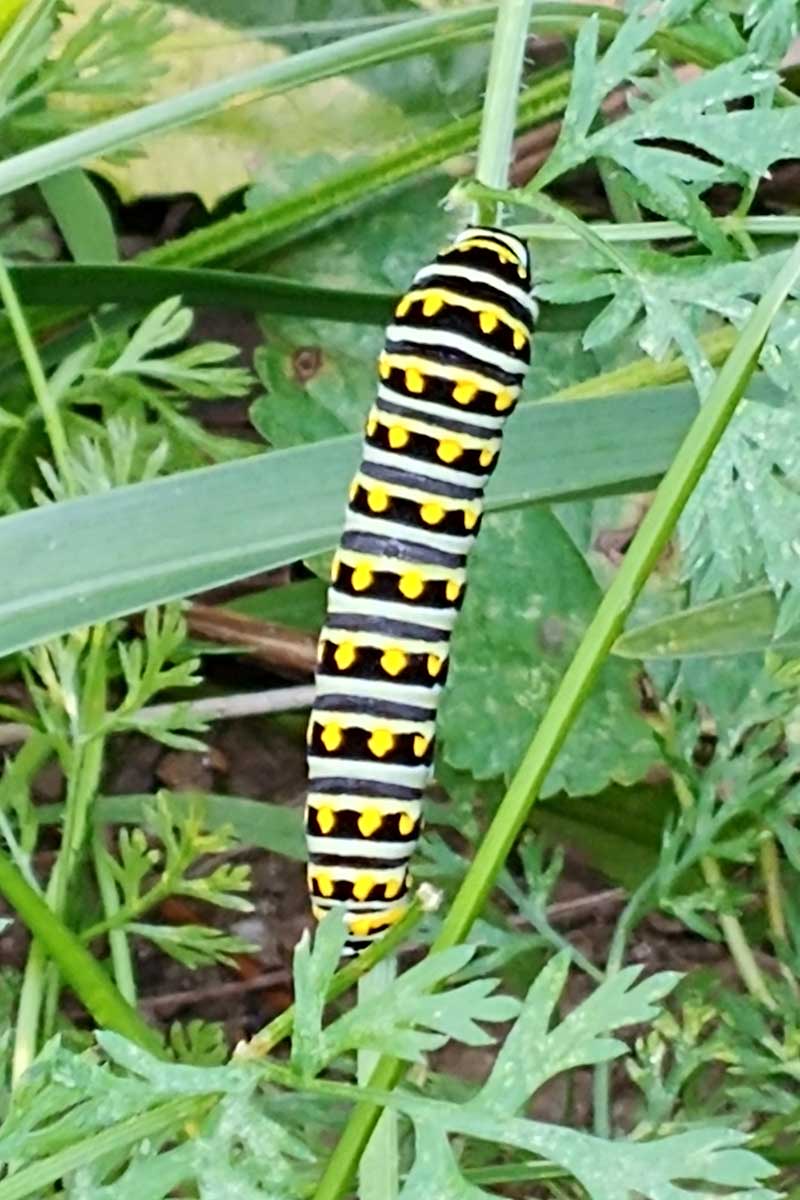
However, sometimes even with the best intentions, we have to contend with herbivores, insect pests, and diseases often borne by these pests.
You may find that rabbits take quite an interest in your plants, but deer and groundhogs don’t seem to care for its aroma.
Some pests to be aware of are:
- Aphids
- Slugs and snails
- Swallowtail butterfly caterpillars, aka parsley worms
- Thrips
To eradicate sap-sucking aphids and thrips, a strong stream of water from the hose may do the trick. An application of organic neem oil may be a beneficial treatment for large outbreaks.
For slugs and snails, you can set traps and then discard those you catch.
As for the swallowtail butterfly caterpillar, you may have mixed feelings. It’s likely to feed on the aphids, but it is also going to feast on the foliage.
If you decide you just can’t share, either pick them off by hand, or try adding a few attractions to the yard like a bird feeder or an inviting birdbath, and let avian visitors help keep them in check.
In addition, there are a few diseases that may present themselves, including:
- Cercospora leaf blight
- Damping off
- Downy mildew
- Powdery mildew
- Rust
We’ve already talked about damping off, a fungal disease that kills seedlings, and for which there is no cure.
These are primarily fungal conditions, with the exception of downy mildew, which is caused by a water mold called an oomycete.
All affect the foliage, causing discoloration and often deformity. They are likely to respond favorably to fungicides formulated for edible plants.
Another disease I recently learned about, called “little leaf,” was documented in India in 2002 .
It appears to be caused by a bacterium called a phytoplasma, and causes witches’ broom-like tiny leaf growth of the foliage, as well as yellowing. It does not seem to be commonplace at this time.
The reason it caught my eye is because while there’s a phytoplasma commonly called aster yellows that causes these symptoms, there’s also a viral condition called rose rosette disease with the same warning signs that is known to be a killer of rose bushes.
In light of this possibility, I recommend not taking the advice of some gardeners who suggest planting fennel beside rose bushes so the swallowtail caterpillars can eat the aphids that often plague them.
Now that we know about cultivation and anticipating issues, let’s talk about harvesting the fruits of our labor.
Harvesting
You can pick the tender young shoots of common varieties to enjoy as tasty microgreens, while mature leaves are exceptional when chopped finely as a fresh herb.
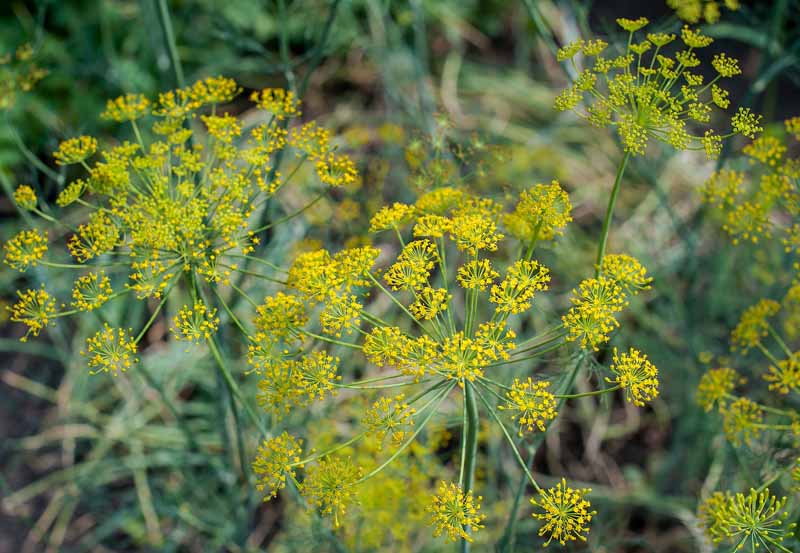
Even the stems can be used, like tough celery, in slow-cooked dishes.
When harvesting, try not to take more than one-third of the entire plant at once to avoid shocking it into bolting, or prematurely running to seed.
You can also harvest the flowers to use fresh, or to dry and scrape off the pollen, which has the most intense anise-type flavor of all.
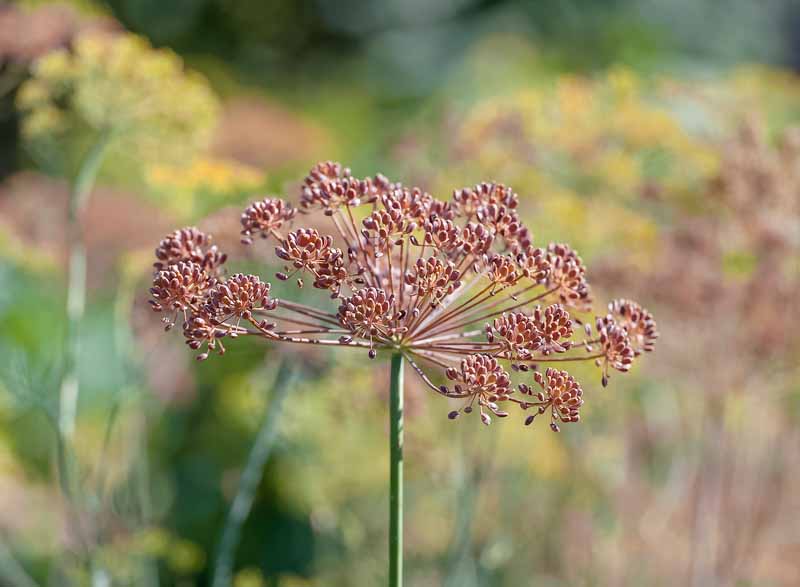
Collect the seeds when they’re green, just after the pods form, or wait until the pods turn brown and the seeds are dry.
For Florence varieties, gather the bulbs when they are about the size of a tennis ball, or at most, four inches across.
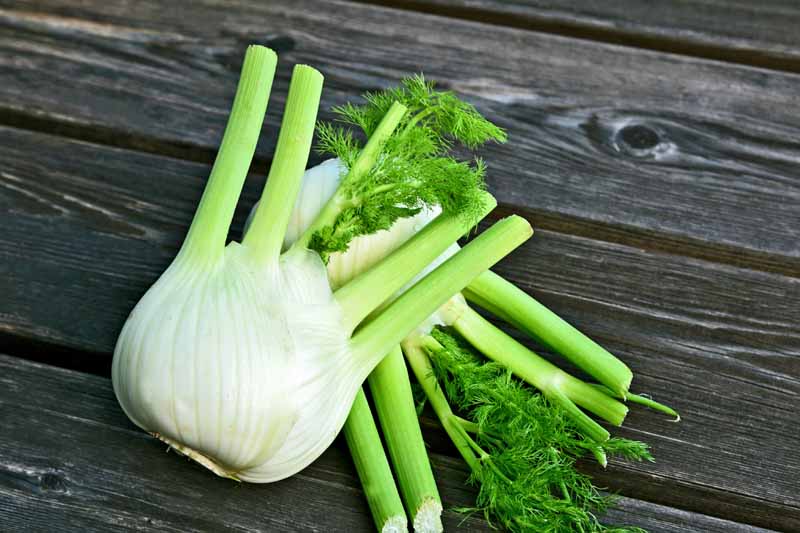
Slice each off at ground level with a clean knife, and slice the elongated stems and profusion of leaves off at about three to six inches above the bulb. All parts can be used!
When they’re harvested young, these plants are finished. There will be no flowers, and therefore no seeds.
If you are growing this type and want flowers and seeds, simply allow some of the bulbs to get larger, and soon flower buds will form, bloom, and set fruit.
Plants may be able to tolerate a light frost, but if there’s a hard freeze predicted, harvest what you can in a hurry, including digging up the roots to use as you would carrots, if you’re so inclined.
Storing and Preserving
To store Florence fennel, cut the long stalks off, leaving about two inches above each bulb.
I like to slice the bulbs of Florence types in sections about an inch thick, and store them covered in water in an airtight container in the fridge.
Each morning I change the water and they last for up to five days, before turning brown and getting soft.
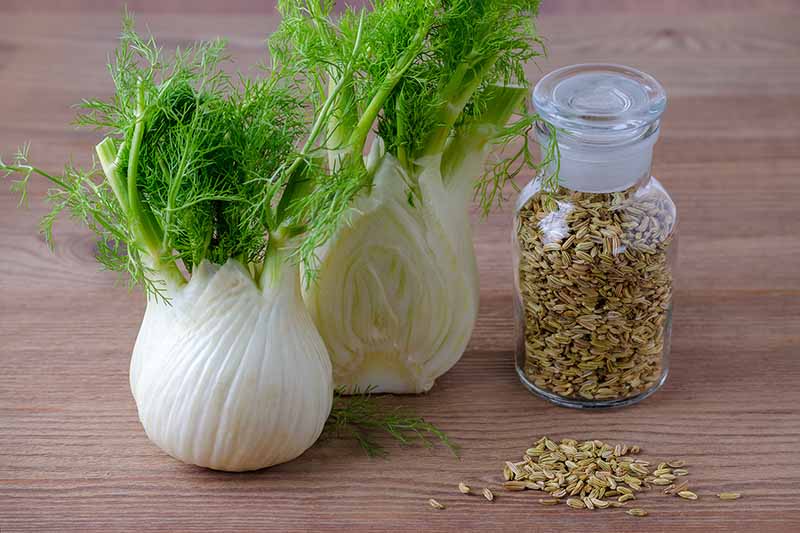
You can also store whole bulbs in the fridge for three to five days, or up to a week and a half if you place a damp paper towel over them.
As for cut foliage, it’s quite delicate, and goes limp quickly. Plan to use it the same day you pick it. Keep it ready by cutting stalks and placing them in a container of water until needed.
Snip off the feathery foliage you want for use in salads and as fragrant garnishes, or toss it into savory cooked dishes as you would with dill.
The stalks can be a little tough, so they’re best in cooked dishes. Some folks dry them in a low oven at about 200°F, for two hours or so.
Fresh, they keep for up to two weeks in the fridge, and are a healthy addition to slow-cooked soups and stews.
Green fennel seeds should be kept in the fridge and consumed within a week of picking.
Pollen scraped and gathered from dry flowers saves well in a sealed jar for approximately two years.
Dry seeds should remain robust and aromatic for several years when stored in an airtight jar. Keep them handy to use as a spice, or to chew a few as a digestive aid and breath freshener.
Find even more information about storing and using fennel on our sister site, Foodal.
Recipes and Cooking Ideas
From flowers, foliage, and pollen, to bulbs, seeds, roots, and the extraction of essential oils, F. vulgare varieties offer much to the home cook.
And, the aromatic essential oils released from the chemical compounds, including anethole and fenchole, do indeed possess anti-inflammatory and anti-bacterial properties, and promote digestion, just as the ancients believed.
Here are some of my favorite recipes you’re sure to enjoy that call for this stellar herb:
If you’ve never liked brussels sprouts, then you haven’t tried them al dente, cooked with bacon, and flavored with the taste of fennel and fresh dill.
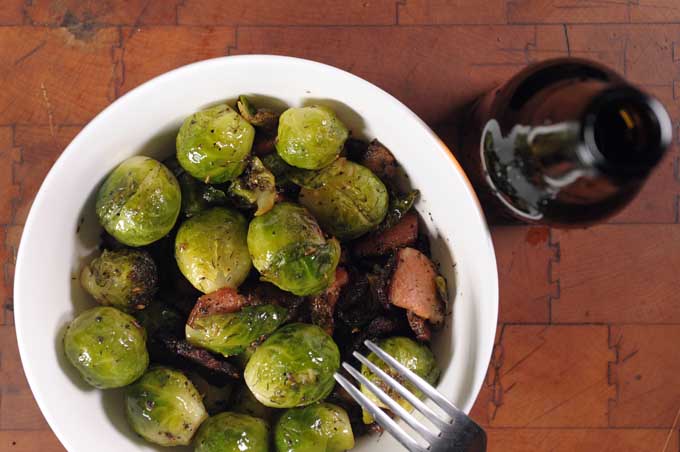
Besides the incredible flavor, the fat from the bacon allows fat-soluble nutrients to absorb more easily into the body.
Check out the recipe now on Foodal.
Are you looking for an easy, no-cook sauce to make a quick crostini or bruschetta?
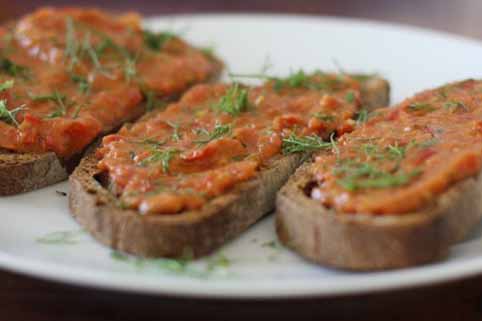
Try this tasty recipe for balsamic tomato and fresh fennel sauce, prepared with fresh fennel and cherry tomatoes, also on Foodal.
You can also serve this tasty sauce on top of pasta, spiralized veggies, or anything you would usually serve with marinara.
Do you love a good healthy tea?
This fennel nettle iced tea blend from Foodal is naturally sweet and has powerful natural benefits. It’s a restoring take on an ubiquitous beverage, with unique flavors.
And for more inspiration on using fennel in your culinary creations, check out Foodal for more recipes.
Quick Reference Growing Guide
| Plant Type: | Short-lived perennial aromatic herb | Flower/Foliage Color: | Yellow/green, bronze |
| Native to: | Southern Europe | Maintenance: | Low |
| Hardiness (USDA Zone): | 4-9 | Tolerance: | Some drought, deer, groundhogs |
| Season: | Cool-weather late spring, late summer/fall | Soil Type: | Organically-rich loam |
| Exposure: | Full sun | Soil pH: | 4.8-8.2 |
| Spacing: | 12-18 inches | Soil Drainage: | Well-draining |
| Planting Depth: | 1/4 inch (seeds) | Attracts: | Beneficial pollinators |
| Time to Maturity: | 60-90 days | Avoid Planting With: | Other Apiaceae family members, especially dill |
| Height: | 2-6 feet, depending on variety | Family: | Apiaceae |
| Spread: | 18-36 inches | Genus: | Foeniculum |
| Water Needs: | Moderate | Species: | vulgare |
| Common Pests and Disease: | Aphids, parsley worms, slugs, snails; Cercospora leaf blight, damping off, downy mildew, powdery mildew, rust | Subspecies: | capillaceum, piperitum |
All-In-One Flavor and Versatility
Now you have the low-down on fennel varieties. If you love the crunch of celery, and the licorice-like flavor of anise, this herb is going to be the new star in your garden and on your table.

With rich soil that drains well, and timely planting in cool weather, you can enjoy both common and Florence fennel types in your garden.
It may not be the best garden companion, but that’s just because it wants to keep its amazing flavor all to itself.
Add fennel to your garden planner today, and make room for your new favorite herb, spice, and vegetable all rolled into one!
If you’re a fan of growing herbs, check out some of our other growing guides next:
- How to Grow Mitsuba
- How to Grow Parsley in Your Home Herb Garden
- Summer Savory: The Peppery, Piquant Love Herb
- How to Grow Horehound
Photo by Nan Schiller © Ask the Experts, LLC. ALL RIGHTS RESERVED. See our TOS for more details. Originally published February 22, 2019. Last updated March 11, 2021. Product photos via Burpee and True Leaf Market. Uncredited photos: Shutterstock.
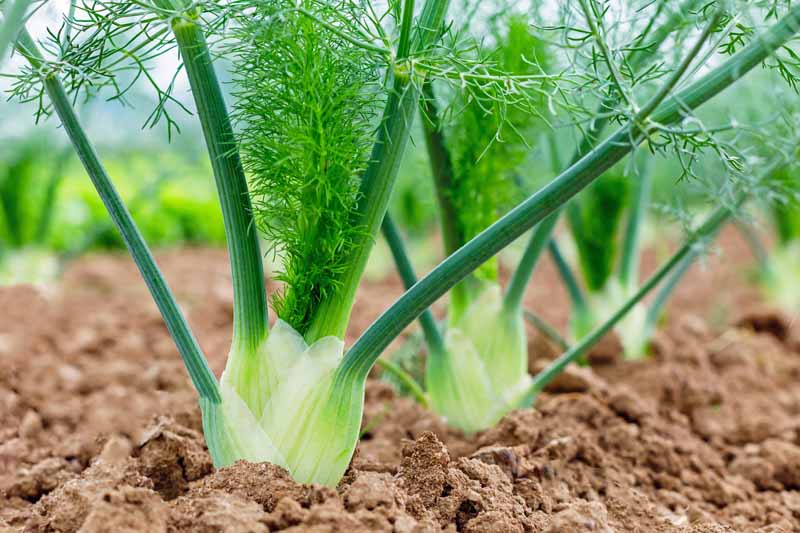
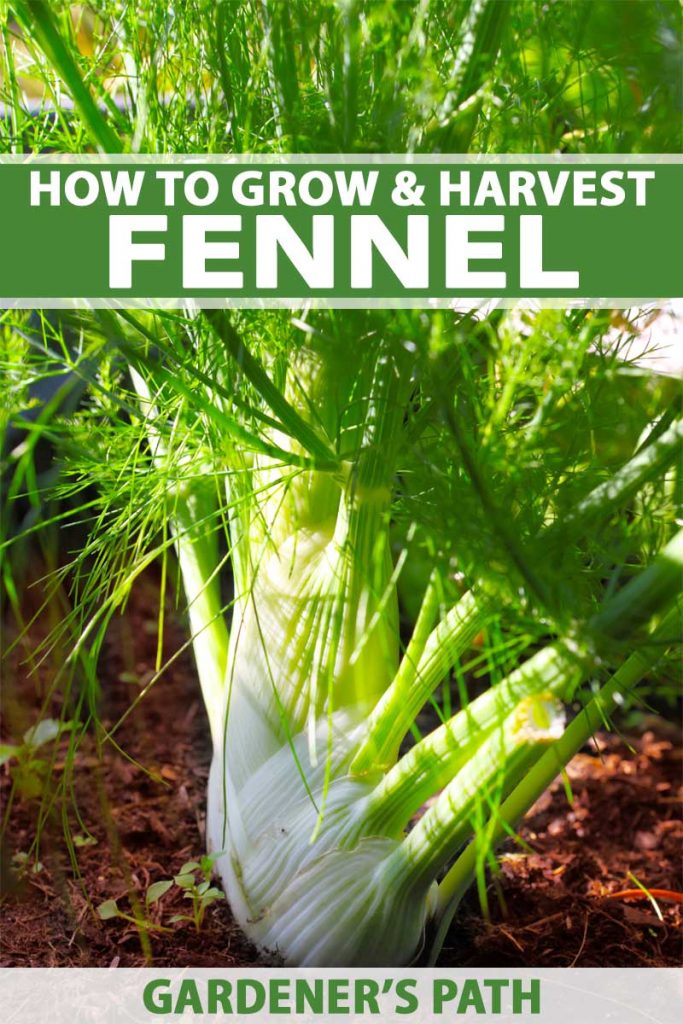
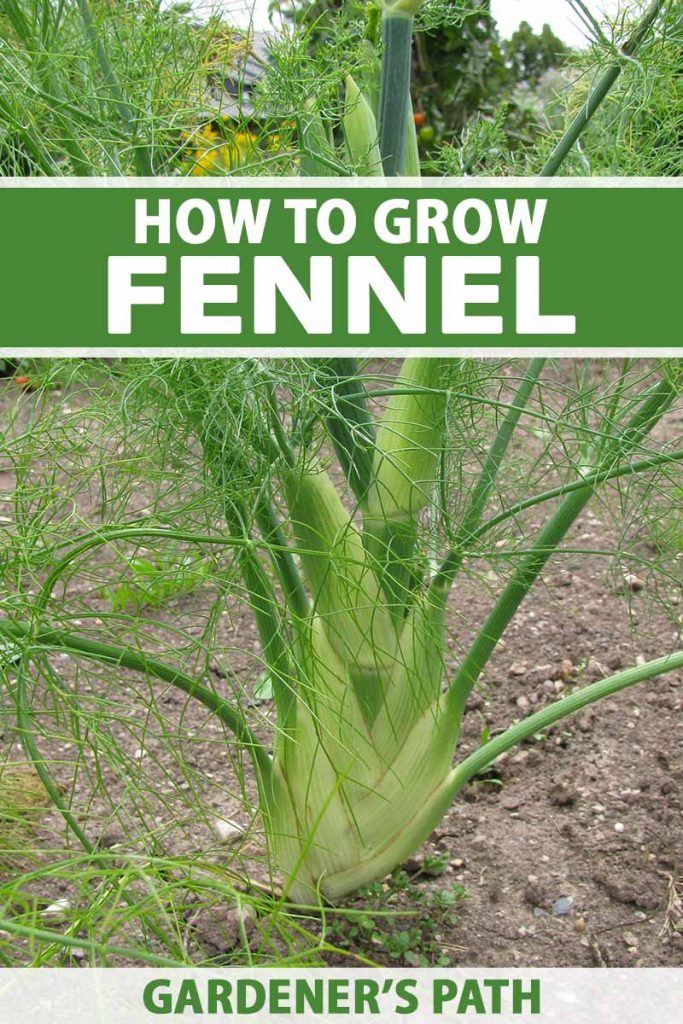
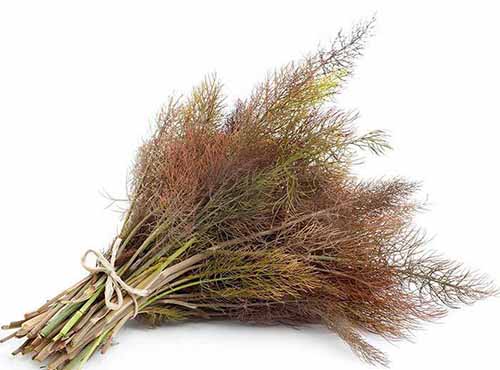

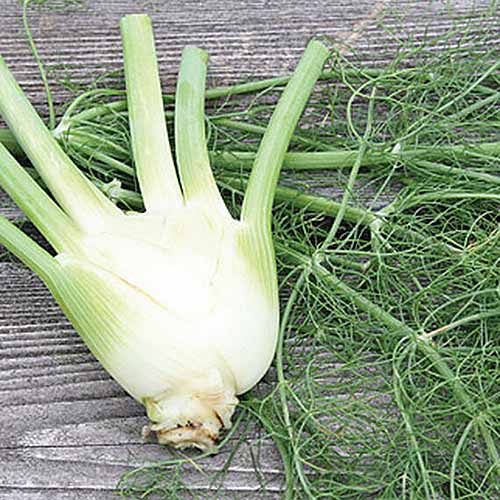
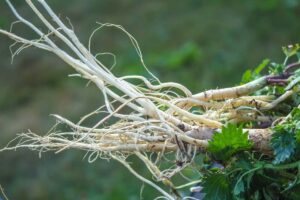
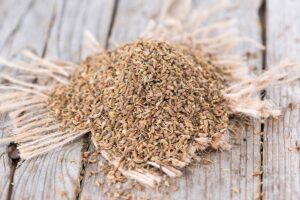
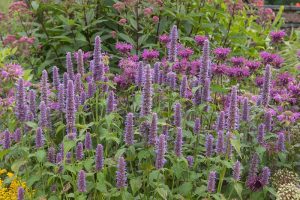
HELP! The fennel’s fine but it seems my plant came with 4 caterpillars! Nice hefty ones, eating the fennel all day long. Other herbs in pots on my deck, but decided to transplant the fennel into the ground for caterpillars sake. Asking: This is NY. Will the cyrysalses form in a few weeks, turn to butterflies during the summer? Happen right on the stalks of fennel? Need a stick to be placed nearby? What are predators – of either caterpillars or chrysalis? Should I place some netting over the plant?
What do the caterpillars look like, Sandy? Can you send a photo? Do yours look like the photo in the article above? And you mentioned other herbs- are you growing dill or parsley as well? Swallowtail butterflies like to lay their eggs on fennel and other members of the parsley family, and they should be left alone if possible, to encourage the native pollinators to thrive in your garden. Their caterpillars, aka “parsleyworms” have a striking appearance, starting out black and spiky with a pattern of orange spots, and presenting alternating green/yellow and black stripes with yellow spots as they… Read more »
I planted dill and fennel very near this year. First time growing both. I began to worry about my choice as I watched them grow so similarly. While they were still adolescents I misidentified one of them while tasting it. Their similarities have grown as they have. They seem to have thrived – probably an excellent companion if flavor weren’t an issue – but it is. As it stands I don’t like either. Dill flavored fennel pollen? Not sure about that.
Oh! Thank you for this comprehensive and well written article. I’ll grow fennel again – maybe not the dill.
I have fennel that has tiny green worms on it. I raise black swallowtails and want to know how to get rid of these worms.
Hello Margaret –
The Eastern black swallowtail larvae is a green caterpillar called the “parsley worm.” Can you describe the worm in question by comparing it in size and color to the parsley worm, or perhaps upload a photo of one?
I use to make porchetta with dried finnochio sticks. How do I make these?
My family calls it finnochio as well- and that sounds delicious!
I’m not sure if you’re talking about the fronds or the bulb, but you could cut up and dry the bulbs in the same way as you might celery, in a food dehydrator according to the manufacturer’s directions or in a low oven, and you could dry the fronds in the same way you might dry dill, in a dehydrator, by hanging bunches to dry, or even on low power in the microwave.
Hope this helps!
I had an abundance of fennel cut some down and forgot about them for awhile, it rained(pnw)@nd they got wet then dried out, my husband is afraid of mold, they have been dried out and seem fine I didn’t notice anything, what do you think?
Does fennel belong to plantation crops? Because anise does and I think fennel is just related to Anise family if I’m not mistaken. I hope you can answer my question because I am having my thesis outline.
Thankyou.
Hi Grace –
Fennel and anise are both in the Apiaceae (Umbellifer) family. At this time, India is the largest producer of fennel.